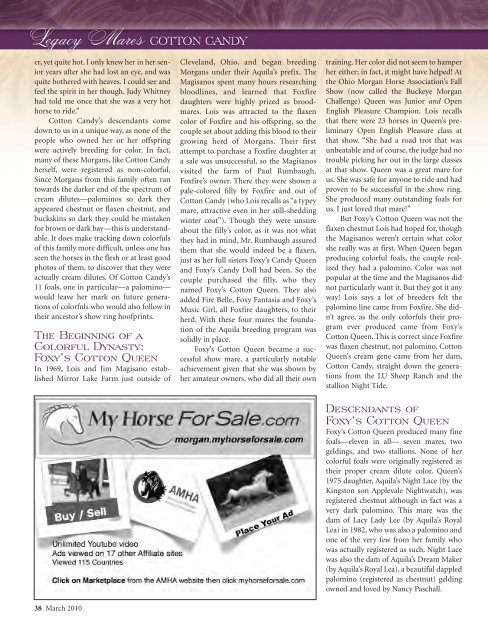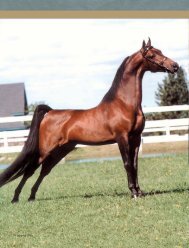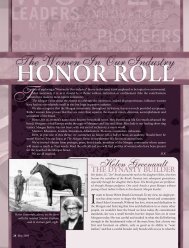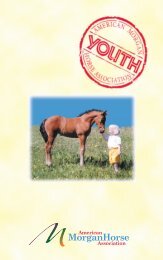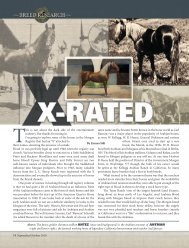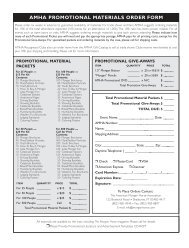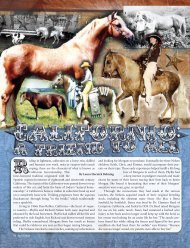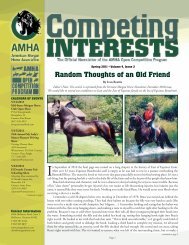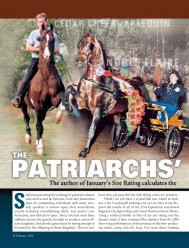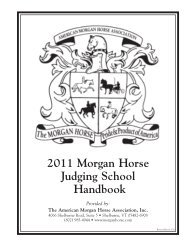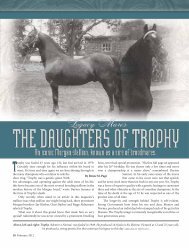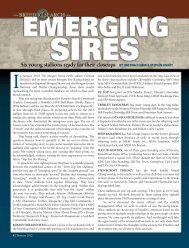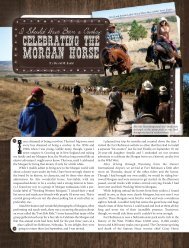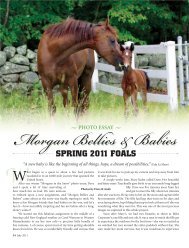LegacyMares CottonCandy 3.10 - American Morgan Horse ...
LegacyMares CottonCandy 3.10 - American Morgan Horse ...
LegacyMares CottonCandy 3.10 - American Morgan Horse ...
- No tags were found...
You also want an ePaper? Increase the reach of your titles
YUMPU automatically turns print PDFs into web optimized ePapers that Google loves.
er, yet quite hot. I only knew her in her senioryears after she had lost an eye, and wasquite bothered with heaves. I could see andfeel the spirit in her though. Judy Whitneyhad told me once that she was a very hothorse to ride.”Cotton Candy’s descendants comedown to us in a unique way, as none of thepeople who owned her or her offspringwere actively breeding for color. In fact,many of these <strong>Morgan</strong>s, like Cotton Candyherself, were registered as non-colorful.Since <strong>Morgan</strong>s from this family often rantowards the darker end of the spectrum ofcream dilutes—palominos so dark theyappeared chestnut or flaxen chestnut, andbuckskins so dark they could be mistakenfor brown or dark bay—this is understandable.It does make tracking down colorfulsof this family more difficult, unless one hasseen the horses in the flesh or at least goodphotos of them, to discover that they wereactually cream dilutes. Of Cotton Candy’s11 foals, one in particular—a palomino—would leave her mark on future generationsof colorfuls who would also follow intheir ancestor’s show ring hoofprints.The Beginning of aColorful Dynasty:Foxy’s Cotton QueenIn 1969, Lois and Jim Magisano establishedMirror Lake Farm just outside of38 March 2010Cleveland, Ohio, and began breeding<strong>Morgan</strong>s under their Aquila’s prefix. TheMagisanos spent many hours researchingbloodlines, and learned that Foxfiredaughters were highly prized as broodmares.Lois was attracted to the flaxencolor of Foxfire and his offspring, so thecouple set about adding this blood to theirgrowing herd of <strong>Morgan</strong>s. Their firstattempt to purchase a Foxfire daughter ata sale was unsuccessful, so the Magisanosvisited the farm of Paul Rumbaugh,Foxfire’s owner. There they were shown apale-colored filly by Foxfire and out ofCotton Candy (who Lois recalls as “a typeymare, attractive even in her still-sheddingwinter coat”). Though they were unsureabout the filly’s color, as it was not whatthey had in mind, Mr. Rumbaugh assuredthem that she would indeed be a flaxen,just as her full sisters Foxy’s Candy Queenand Foxy’s Candy Doll had been. So thecouple purchased the filly, who theynamed Foxy’s Cotton Queen. They alsoadded Fire Belle, Foxy Fantasia and Foxy’sMusic Girl, all Foxfire daughters, to theirherd. With these four mares the foundationof the Aquila breeding program wassolidly in place.Foxy’s Cotton Queen became a successfulshow mare, a particularly notableachievement given that she was shown byher amateur owners, who did all their owntraining. Her color did not seem to hamperher either; in fact, it might have helped! Atthe Ohio <strong>Morgan</strong> <strong>Horse</strong> Association’s FallShow (now called the Buckeye <strong>Morgan</strong>Challenge) Queen was Junior and OpenEnglish Pleasure Champion. Lois recallsthat there were 23 horses in Queen’s preliminaryOpen English Pleasure class atthat show. “She had a road trot that wasunbeatable and of course, the judge had notrouble picking her out in the large classesat that show. Queen was a great mare forus. She was safe for anyone to ride and hadproven to be successful in the show ring.She produced many outstanding foals forus. I just loved that mare!”But Foxy’s Cotton Queen was not theflaxen chestnut Lois had hoped for, thoughthe Magisanos weren’t certain what colorshe really was at first. When Queen beganproducing colorful foals, the couple realizedthey had a palomino. Color was notpopular at the time and the Magisanos didnot particularly want it. But they got it anyway! Lois says a lot of breeders felt thepalomino line came from Foxfire. She didn’tagree, as the only colorfuls their programever produced came from Foxy’sCotton Queen. This is correct since Foxfirewas flaxen chestnut, not palomino. CottonQueen’s cream gene came from her dam,Cotton Candy, straight down the generationsfrom the LU Sheep Ranch and thestallion Night Tide.Descendants ofFoxy’s Cotton QueenFoxy’s Cotton Queen produced many finefoals—eleven in all— seven mares, twogeldings, and two stallions. None of hercolorful foals were originally registered astheir proper cream dilute color. Queen’s1975 daughter, Aquila’s Night Lace (by theKingston son Applevale Nightwatch), wasregistered chestnut although in fact was avery dark palomino. This mare was thedam of Lacy Lady Lee (by Aquila’s RoyalLea) in 1982, who was also a palomino andone of the very few from her family whowas actually registered as such. Night Lacewas also the dam of Aquila’s Dream Maker(by Aquila’s Royal Lea), a beautiful dappledpalomino (registered as chestnut) geldingowned and loved by Nancy Paschall.


